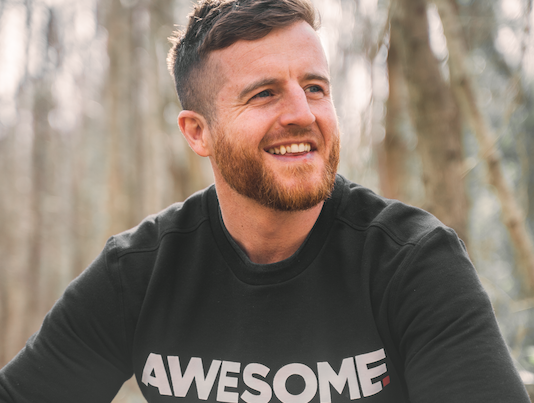Taking on a new client means creating a completely new programme tailored to their needs. We spoke to Morc Coulson about using the six-step client pathway to ensure this can happen.
This standardised system allows you to organise any client data in a way in which it can be easily analysed and interpreted. The six stages are:
- Screening
- Identifying stage of change
- Agreeing goals
- Identifying health and fitness components
- Testing components
- Programme design
Taking on a new client and not wanting to push them away, yet wanting to make sure that you’re fully aware of their health issues in the screening stage, is as crucial as any specific exercise may be for a new client. So, too, is identifying how ready they are to change their attitude towards fitness in some way; that’s all before any specific plan has even been thought of. Motivationally, agreeing the correct goals then becomes crucial to keeping them on-board. Finally, once that’s in place, error-free testing will allow you to really make sure that results are results.
The six-step client pathway, something that Coulson covers in more detail in his book, The Complete Guide To Personal Training, allows you to follow the same steps with each new client and create the perfect tailor-made programme for them.
We were lucky enough to have him on our podcast to discuss common mistakes that personal trainers can make with clients, so be sure to listen to that, too.
Screening a client
Making sure the client is in a condition that is safe to train seems obvious, but it is essential when taking on someone new. One thing that Coulson has noticed is that many people aren’t using the screening process optimally.
“One of the main screening tools we use in this country is the PAR-Q, the Physical Activity Readiness Questionnaire. When instructors use that and their clients answer with a ‘yes’, their default position is, ‘I must send them along to their GP to get clearance’.
“All I encourage my students to do is wait a minute and think about it logically. GPs don’t want everybody sent to them to get clearance for exercise. For example, in the question: ‘Do you have a bone or joint problem that could be made worse by physical activity’? If you ask someone like me, I can give you a list of bone and joint problems that could be made worse! However, I don’t need clearance from my GP. All I need to do is make you, the instructor, aware of what it is, and then the instructor can make an informed decision and work to devise a programme around that,” said Coulson.
Naturally, if there is something that you are unsure of, then the best course of action is to get a professional who is knowledgeable in the field to help with this. While this could mean sending the client to a GP for a referral, Coulson also suggests reaching out to a colleague to help you make a decision.
“Once you’ve sent that client away to get GP referral you may well lose them, so let’s try and keep them. Obviously, though, if it is a problem that requires going to their GP, then of course you have to suggest that step to them. But, let’s try to hang on to clients and use common sense before sending them away.”
Why is behavioural change so important?
Here, you are looking to understand how motivated the new client is to change their behaviour so that you can identify what type of strategy to use when designing their programme.
“It comes down to one word: adherence,” said Coulson. “We need clients to stick to programmes. When a client comes to you, you have to determine the best strategies to keep them coming back. These are called behavioural change strategies. It’s great to read around the science, but because the clients have already come to us we don’t need to do that – we just need to ask a couple of simple questions about where they are in their stage of thinking about this exercise.
“Obviously they’ve thought about it, but have they done anything? Have they tried some exercise, or are they really just thinking about it and have just come to you? That stage there is the contemplation stage, meaning you have to reinforce the messages:
Why do they need to come to you? Why is exercise a benefit? What are the good things, not just health-wise but socially, about exercise?
“You have to provide the motivation, whether that’s through you or a training buddy, to stop the relapse. Look at what strategy you should use depending on where the client is in terms of this contemplation for exercise, or being already actively involved.”
Setting realistic goals
“Research tells us that, without goal setting, clients will go into relapse: leaving us; dropping out; giving up.” Clearly this is why it is so important that you set the correct type of goals for your clients.
“Instructors will know about smart goals. One of the key things is that they are achievable – goals that are set at times when we’re going to be able to show some improvement,” describes Coulson.
“There are two types of goals: process goals and outcome goals. For beginners, we need to focus on process goals. It’s something very general such as taking part in an aerobics class and keeping going for a few weeks. Can you get into a fast, brisk walk without feeling like your heart is going to come out of your chest? These are process goals.
“Outcome goals are very specific. This is when we’re in that cycle of exercise and we’re not really in danger of relapse, so as a result we need to set very specific goals. This could be around achieving a 3kg weight-loss target in X amount of months. Or run a half marathon by next September. Start with the general goals and then move on to the more specific ones.”
Testing baseline fitness
Here, it’s best to stick to the basics. Then, you can build up and create a more progressive programme for your client, but the critical thing to do is establish a solid baseline. Regardless of what stage your client is at, from amateur to athlete, testing is essential. The question is what type?
“All clients will need testing regardless of who they are or what they want to achieve. Your baseline testing must be geared towards the goals of the client, so if the client has a cardio goal then we need to be doing some kind of cardio baseline testing.
“That’s easily said, but what I’d like instructors out there now to do is look at the range of tests available for each of these fitness components. For example, with cardio, there are myriad different tests that can be done, but not all of them are appropriate for various populations. Using the Multi-stage Fitness Test as an example, this would not be suitable for beginners. It is a maximum test, usually done with group athletes. However, a Rockport Walking Test would be very suitable for them. So when selecting the appropriate tests, you have got to look at the test in detail to see whether it is suitable for that particular client.”
Taking it further than that, to make the test as empirically correct as possible, baseline and retesting should endure the same amount of motivation, occur at the same time, and both share a similar build up. Giving examples, Coulson added: “Look at the state of the client, did they just have a work out? Did they have a really intense football game the day before?”
Designing a client’s program
“Looking at the Frequency Intensity Time (FIT) guidelines, that is the starting point for all programme design.”
How many times a week a client will exercise, what sort of intensity their training will be at, and for how long this will continue, all build up the programme. It’s important to begin with this and not rush into how this will progress too soon. One step at a time.
“Once I’ve got that, then I can think about things such as progression. For instance, with a resistance programme, when something such as 10RM becomes quite easy and the client can do 12-13 reps, that’s time to progress – there’s a built-in progression. With something such as cardio, we can go to the literature. Read around the literature, evidence based, to tell you how to progress different exercises.
“It’s all about starting with the FIT guidelines and creating a strong programme from the beginning.”
Scale of time
This is something that is entirely unique and should be assessed every time with a fresh perspective – because every client is different. The temptation may be there to use tried and tested scales, but giving each client their own programme and allowing them to have their own individual importance is key for a ton of reasons.
“One of the best ways to move forward in this particular industry is word of mouth. It’s key to make a success of every single client, and the only way that we can do this is through meticulous planning and really considering the design of the programme.
“There isn’t a one size fits all, it’s got to be individual. You have to educate clients that this programme and baseline testing is absolutely individual to them and that is what is key to their success.”
Following this individualistic route will ensure that each client gets the best programme for them, which then represents you as a trainer who is about putting a client’s needs first. Each new client represents the opportunity to change someone’s outlook on fitness and, with that, comes another person ready to support and endorse your business.
*








